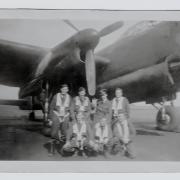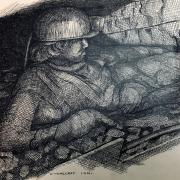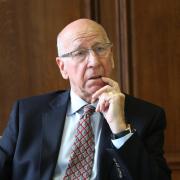Did you know that Wirral and North Wales were at the forefront of a pioneering transport system? WORDS BY MARTIN HANDLEY
It’s probably fair to say that you wouldn’t expect either Rhyl, in North Wales, or Wallasey, on the Wirral to be at the forefront of pioneering transport systems.
Yet these two towns were at either end of the world’s first hovercraft passenger service, which operated between them for a very brief period 50 years ago this summer. The hovercraft had been patented only seven years earlier by Christopher Cockerell. He had worked on airborne navigation systems during the war, while employed by the wireless company, Marconi. He left them in 1950, and set up a boatyard in Suffolk, where he conducted experiments into the reduction of friction between craft and water.
The hovercraft was the result, a device which apparently the Patents Office did not know whether to class as aircraft or boat, and which the Government, when they heard of it, insisted be developed in secrecy. The hovercraft was finally declassified in 1959 and Cockerell received his patent a year later.
In 1960 British United Airways was formed from a merger of smaller companies, and it was they who decided to operate the passenger service between Rhyl and Wallasey. A VA-3 Vickers Armstrong craft of 54 feet in length and 27 feet in breadth was shipped around the coast from Southampton to the Mersey.
It was then driven to Rhyl, where it arrived on 19th July 1962. It came to be based at Horton’s Nose Foryd. The hovercraft weighed 12 tons, had a range of 100 miles and could reach speeds of 60 knots (69 mph). In charge on its inaugural flight/cruise were to be Captain L R Colquhoun and Captain R T Old.
At 9.30 on the morning of July 20th, a large crowd had gathered to see the hovercraft make her first passage of the 17 miles across the waters to Wallasey. On board were 24 passengers, together with two mailbags, containing a total of 8,000 items, many of which had been marked with a commemorative stamp for the occasion. The journey (expected to take 25 minutes) took a little longer than anticipated and 32 minutes elapsed before the hovercraft docked at Leasowe Common, Wallasey, having completed its run at an average speed of 28 knots (32 mph).
The anticipated 20-minute turnaround was almost achieved, and at 10.25 the craft commenced the return journey, arriving in Rhyl 15 minutes late. It was intended that the service would involve 12 crossings daily (six each way at mainly 90 minute intervals) and operate on six days of every week, with Tuesday being the exception. The fares were set at �1 single and �2 return.
Sadly, that first morning was about as good as it got for the world’s first passenger hovercraft service (or the Hovercoach, as it was then known).A series of mechanical difficulties would follow and the weather was unusually stormy that summer.
The result of this was that, although the service was scheduled to end anyway on September 16th, it concluded two days early and had only managed to operate at all on 19 days during the two months of expected service. In all, only 172 crossings were made – an average of nine per day over the 19 days, instead of the expected 12 – and 3,765 passengers carried. At least the crossings that did take place were nearly fully subscribed, with an average of 22 passengers per trip, the maximum payload being 24.
The Queen and Prince Philip had received an invitation to undertake the trip, but declined – perhaps just as well, for on what proved to be the final journey the hovercraft left Wallasey at 1.15 p.m. on September 14th and both engines failed en route.
The vehicle limped tamely into Plastirion Slipway (near the modern Sun Centre) at Rhyl rather later than intended. The service had only once managed four consecutive days of operation (August 28th-31st) and had been off the water completely between September 1st and 10th for mechanical repairs.
It had been a brave venture, but it all came to a sad end when, on September 17th a bout of heavy weather caused the craft to break her moorings with the crew on board. The Rhyl lifeboat mounted a successful rescue of the crew, but the hovercraft was dashed against the groynes.
The expense of repair on-site was deemed uneconomic and a pair of cranes was subsequently employed to lift and remove VA-3. In time, repairs were made and the craft was shipped to the USA for demonstration purposes.
By 1966 it was back in England and ended its days rather incongruously in the Solent, where the Royal Navy attempted, unsuccessfully, to detonate a mine and sink it. Where the technology of explosion had failed, recourse to the pick and hammer would succeed. A team of Navy personnel hacked the bottom out of VA-3 and it sank ignominiously into the Solent, still in 1966.
Christopher Cockerell was 49 when the first hovercraft trial took place at the end of May 1959. Further testing resulted in a decision to make the trip across the English Channel in SRN-1, of Saunders-Roe construction.
The journey was scheduled for July 25th that year – exactly half a century since Louis Bleriot had become the first person to fly solo across that water. It was a success and hovercraft travel was underway. The first scheduled service across the English Channel followed in 1968, by which time many of the mechanical issues – such as introducing a flexible skirt around the air cushion, thus giving greater lift – had been resolved.
By the 1990s, SRN-4 Mark III had been developed and was capable of carrying in excess of 400 passengers, as well as 60 cars, at a steady 65 knots (75 mph) - twice the speed of the fastest ocean liner.
Christopher Cockerell received a knighthood in 1969 and decided to sell his patent rights to the Heath government two years later in 1971. He did not receive monies to the value of his work and despite some success as a company director in the late 1970s, Sir Christopher died in relative obscurity in 1999, at the age of 88.
The print version of this article appeared in the June 2012 issue of Cheshire Life
We can deliver a copy direct to your door – order online here


























